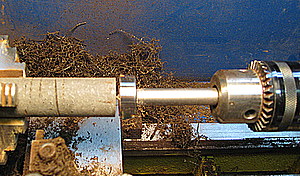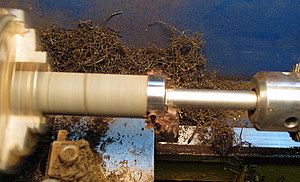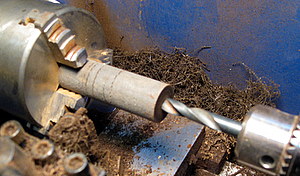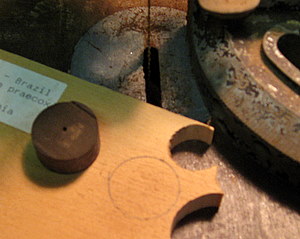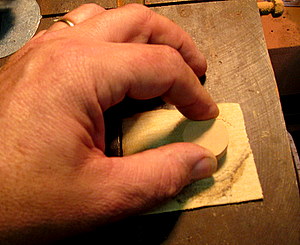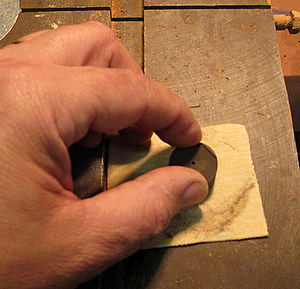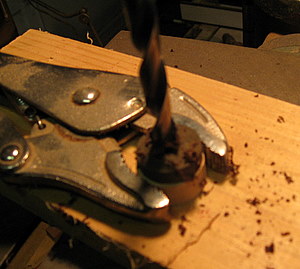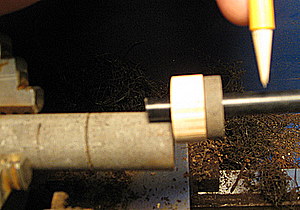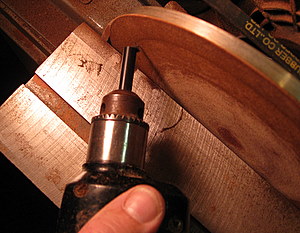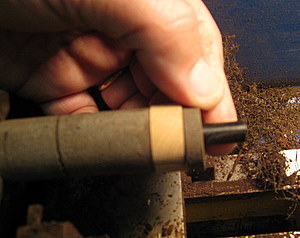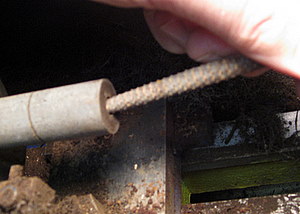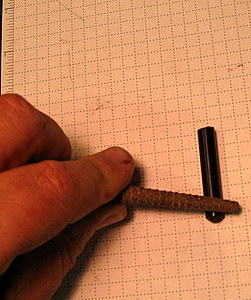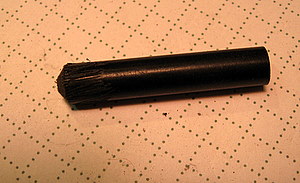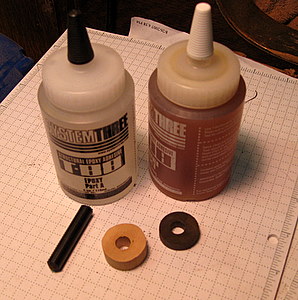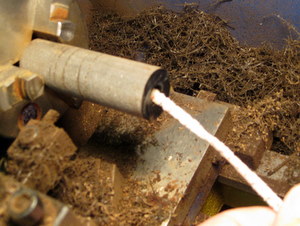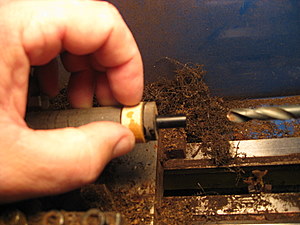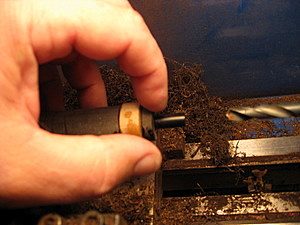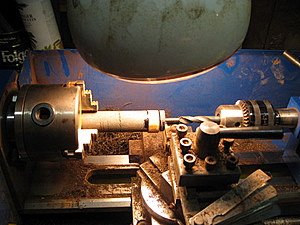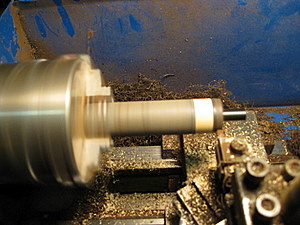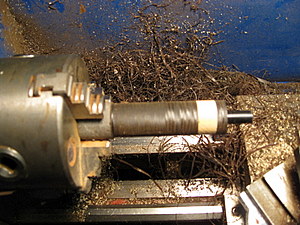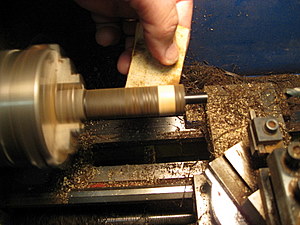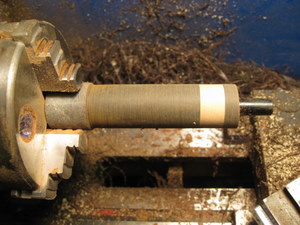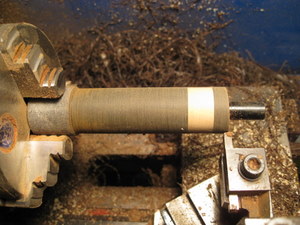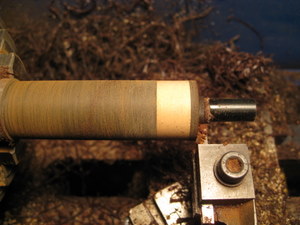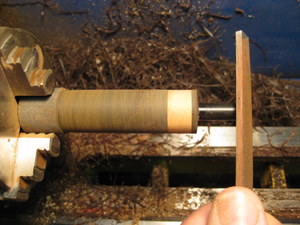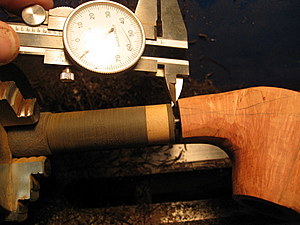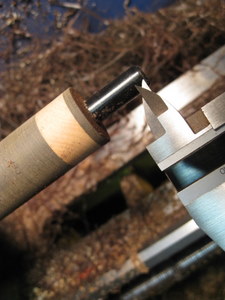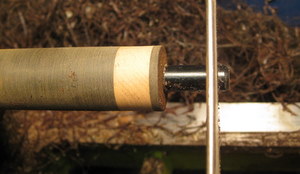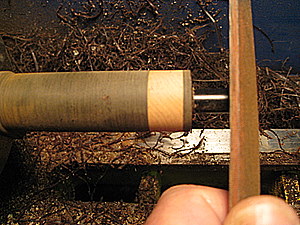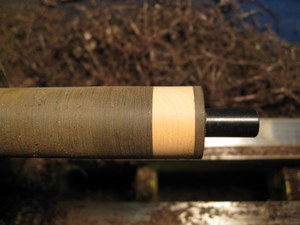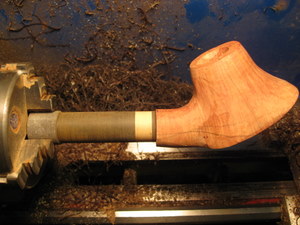Stem Inserts
As with any aspect of pipe making, there are many ways to achieve good results with stem inserts. The following method is constantly evolving, but may prove helpful to some in developing their own:
Preparing the stem: Note: If convenient, consider leaving the stem material in the lathe for the entire process (glue up and drilling). This prevents having to re-center it for drilling operations. Multiple sessions where the stem is in and out of the lathe can introduce problems, even with self-centering chucks.
Prepare the stem material in the lathe by first roughing in the diameter of the stem rod by turning it down. Then face the end as you would normally. The following pics show that being done with a Forstner bit:
When cutting the tenon in the stem material, make sure it is long enough to accommodate your insert material and still allow for fitting the length to exactly bottom out in the mortise (see Turning Tenons). Or if you're using Delrin, drill a 5/16" hole (or whatever size Delrin your using. See Using Delrin Tenons). In the example pictures the inserts will be glued in with a Delrin tenon. Drilling the hole for the Delrin:
Preparing the inserts: Slice sections of the material to be used for the cap and insert material(s).
They must be thicknessed and flattened so they fit perfectly together without any gaps or voids. This can be done by sanding on both sides with sandpaper backed against a good flat surface (the top of a flat work bench works, but a thick piece of glass, granite, or marble would would be better).
Care must be taken the sides of the slices are parallel. This can be checked with calipers. You can leave the outside cap material thicker and do not need to worry about the outside surface which will mate with the stummel. It will be finished by facing it off with the lathe after its glued up, which insures a good fit to the shank, and also allows for tweaking the design aesthetically by adjusting its final thickness. Insure the insert and stem materials are completely flat and fit together without any gaps or voids between them. Then, while keeping the material together as it will be glued up, drill a slightly oversize hole hole through the center of them using a drill press (using 1/64" oversize drill allows the materials to fit flat against the main stem and each other by avoiding the possibility of binding on the tenon).
Next if using Delrin, measure and cut the section to be used. Make sure you leave extra length to allow for trimming it to perfectly match the depth of the mortise:
Round the end of the Delrin to match the bottom of the hole drilled in the stem material. This will minimise any voids and pockets of epoxy:
Glue up: First dry fit everything to ensure your fit is good:
Roughing up the Delrin, and the hole in your stem material will greatly improve the bond between the two materials:
Then mix up epoxy and coat both surfaces of each piece (insert materials, stem, and the inside surface of your end cap):
Use a thin even film of epoxy. Also coat the tenon where the insert material and cap will be in their final positions. If using Delrin, coat that portion which will be in the stem, and surrounded by the inerst material and glue it into the stem at the same time as you're gluing up the inserts. Rotate and press all the materials against each other to release any air bubbles and squeeze out any extra epoxy:
Carefully wipe away any squeeze out off of the tenon (the squeeze out around the outside of the stem and insert materials can be easily trimmed when it's dry, but the tenon should stay as clean as possible). Then use the trimming tool in the cross carriage of the lathe to press the insert materials against the main stem and to each other and lock it into position. If using Delrin use something in the tail stock to press the Delrin firmly into the stem while the epoxy sets, and lock it into position.
These serve as excellent clamps. If possible, let all that sit overnight, or until well cured (5 minute epoxy will speed the set time in terms of clamping, but will still not be fully cured for some time. It is risky to machine the stem assembly until it is fully cured). When ever possible, I leave the assembly in the lathe through the entire process. During cold or damp weather I leave the light down close over the assembly (as shown above) while the epoxy is curing.
Trimming:Get the tool carriage and tail stock out of the way and rough trim the insert materials by hand with a coarse file or fine saw until they are round enough not to catch while turning, then spin up the lathe and trim and sand the inserts flush with a good sharp HSS cutting tool and sandpaper. If your design accommodates planning ahead at this stage, work toward getting close to the thickness you want for the stem/shank joint:
Next, trim the end cap to the desired thickness and face it off so the surface will be fit flush against the stummel.
At this point you can finish fitting the tenon precisely to the mortise. All that has to look perfect with the stummel at before going ahead:
Next drill and countersink the air hole in the stem as you would normally. See Using Delrin Tenons or Drilling Vulcanite Rod. Then it's ready to take out of the lathe.
Notes: I've experimented with gluing up the insert sandwich before drilling it, but that does not seem to work out well. I've also experimented with using pigmented (black) epoxy. That helps to fill any voids in the fit, but also tends to wick into the insert material, especially if it is at all porous. It is best to work until you're sure the joints are really good and go with clear epoxy.
